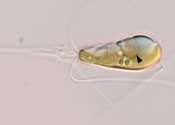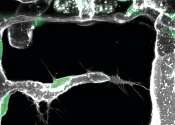Spiraling insights: Scientists observe mechanical waves in bacterial communities
A new study by researchers from The Chinese University of Hong Kong has reported the emergence of mechanical spiral waves in bacterial matter.

A new study by researchers from The Chinese University of Hong Kong has reported the emergence of mechanical spiral waves in bacterial matter.

Modern biology textbooks assert that only bacteria can take nitrogen from the atmosphere and convert it into a form that is usable for life. Plants that fix nitrogen, such as legumes, do so by harboring symbiotic bacteria ...
Cell & Microbiology
Apr 11, 2024
0
3719

Scientists are normally happy to find regularities and correlations in their data—but only if they can explain them. Otherwise, they worry that those patterns might just be revealing some flaw in the data itself, so-called ...
Analytical Chemistry
6 hours ago
0
1

Human mini-lungs grown by University of Manchester scientists can mimic the response of animals when exposed to certain nanomaterials. The study is published in Nano Today.
Bio & Medicine
7 hours ago
0
38

Egg cells are the largest single cells on the planet. Their size—often several to hundreds of times the size of a typical cell—allows them to grow into entire organisms, but it also makes it difficult to transport nutrients ...
Molecular & Computational biology
9 hours ago
0
211

Humans, Homo sapiens, have unique features compared with other closely related hominin species and primates, including the shape of the base of the skull. The evolutionary changes underlying these features were significant ...
Evolution
Apr 17, 2024
0
57

The calcium-sensing receptor is critical for maintaining healthy calcium levels, but CaSR is also well-known for its side hustles. The receptor is increasingly recognized for its ability to detect other ions and proteins ...
Molecular & Computational biology
Apr 17, 2024
0
30

Researchers at Weill Cornell Medicine have developed a powerful, new technique to generate "movies" of changing protein structures and speeds of up to 50 frames per second.
Molecular & Computational biology
Apr 17, 2024
0
2

Cardiovascular diseases, including stroke and myocardial infarction, are the world's leading causes of mortality, accounting for more than 18 million deaths a year. A team of KIT researchers has now identified a new cell ...
Cell & Microbiology
Apr 17, 2024
0
19

A trio of biologists and veterinarians with CRG Barcelona, the University of Cambridge and The Barcelona Institute of Science and Technology, respectively, has found evidence contradicting results found by a prior team of ...
The cell is the structural and functional unit of all known living organisms. It is the smallest unit of an organism that is classified as living, and is often called the building block of life. Some organisms, such as most bacteria, are unicellular (consist of a single cell). Other organisms, such as humans, are multicellular. (Humans have an estimated 100 trillion or 1014 cells; a typical cell size is 10 µm; a typical cell mass is 1 nanogram.) The largest known cell is an unfertilized ostrich egg cell.
In 1835 before the final cell theory was developed, a Czech Jan Evangelista Purkyně observed small "granules" while looking at the plant tissue through a microscope. The cell theory, first developed in 1839 by Matthias Jakob Schleiden and Theodor Schwann, states that all organisms are composed of one or more cells. All cells come from preexisting cells. Vital functions of an organism occur within cells, and all cells contain the hereditary information necessary for regulating cell functions and for transmitting information to the next generation of cells.
The word cell comes from the Latin cellula, meaning, a small room. The descriptive name for the smallest living biological structure was chosen by Robert Hooke in a book he published in 1665 when he compared the cork cells he saw through his microscope to the small rooms monks lived in.
This text uses material from Wikipedia, licensed under CC BY-SA